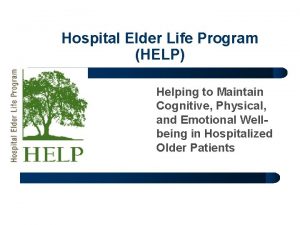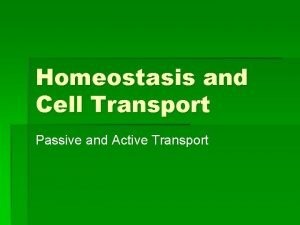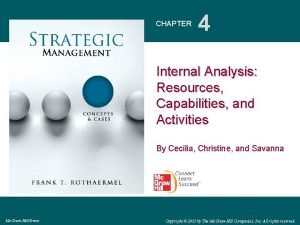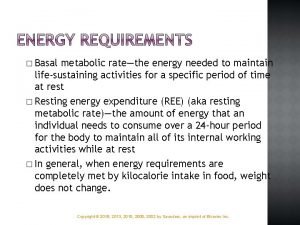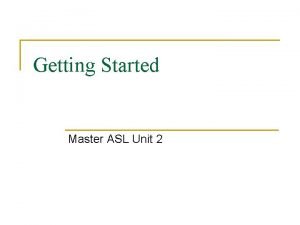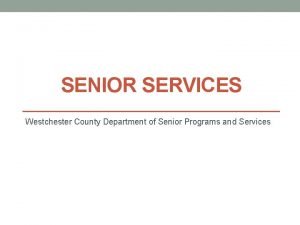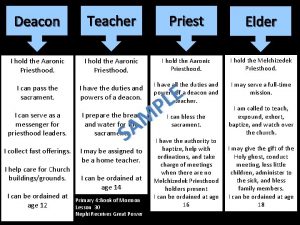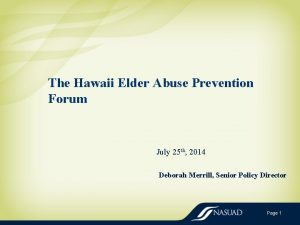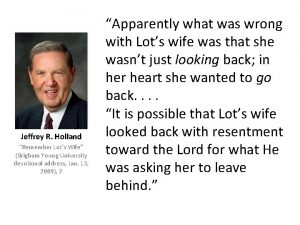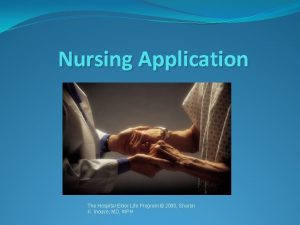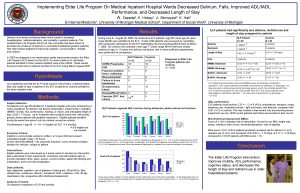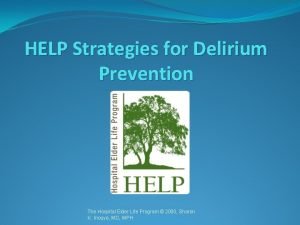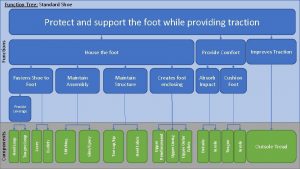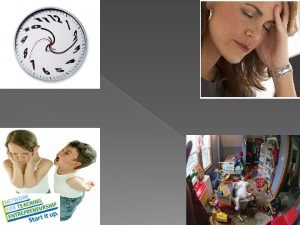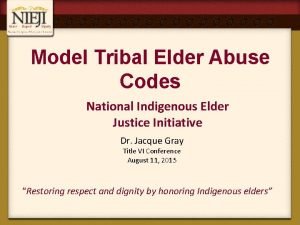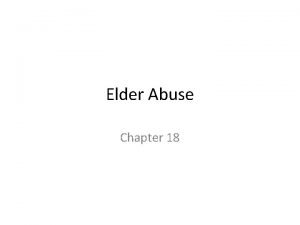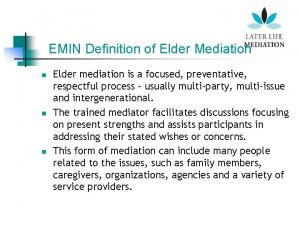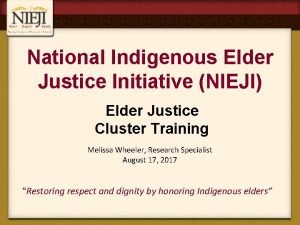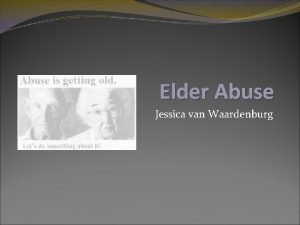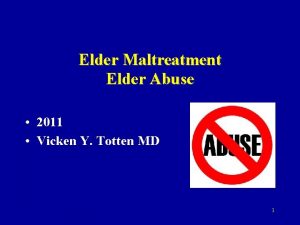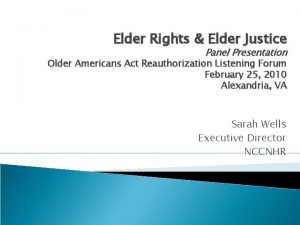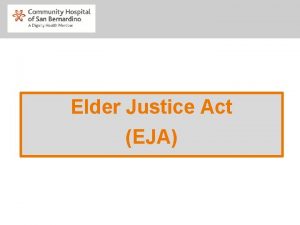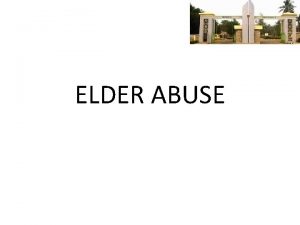Hospital Elder Life Program HELP Helping to Maintain





















- Slides: 21

Hospital Elder Life Program (HELP) Helping to Maintain Cognitive, Physical, and Emotional Wellbeing in Hospitalized Older Patients

What Is the Hospital Elder Life Program? l A comprehensive program of care for hospitalized older patients, designed to PREVENT delirium and functional decline l Based upon award winning clinical trial that demonstrated clinical effectiveness l Demonstrated cost-effectiveness through lower resource use during hospitalization l Target patients = >70 year olds with LOS > 2 days All uses of this material should acknowledge: © 1999, Hospital Elder Life Program, LLC

HELP Program Goals l l Maintain physical and cognitive functioning throughout hospitalization (through daily interventions) Maximize independence at discharge Assist with the appropriate transition from hospital to home or step-down setting Improve geriatric skills of staff throughout the general medicine units All uses of this material should acknowledge: © 1999, Hospital Elder Life Program, LLC

Key Interventions of the Program l l l l Daily visitor program with structured cognitive orientation Therapeutic activities program Early mobilization Non-pharmacologic sleep protocol Hearing and vision protocol Feeding and fluid assistance Geriatric patient care education for unit nurses All uses of this material should acknowledge: © 1999, Hospital Elder Life Program, LLC

Innovative Staffing Model l l Utilizes a small team, comprised of a new role, the “Elder Life Specialist” (ELS) and an advanced practice geriatric nurse, the “Elder Life Nurse Specialist” (ELNS), with support from a geriatrician Uses structured program with detailed orientation and oversight to engage a VOLUNTEER force of 20+ individuals to provide 3 shift, 7 day/week coverage to several hundred elderly patients per year All uses of this material should acknowledge: © 1999, Hospital Elder Life Program, LLC

How Are Volunteers Utilized? l l l Volunteers attend 16 hours of classroom training, followed by precepted practice. They participate in periodic retraining and a formal quality assurance process Volunteers are scheduled for 3 -4 hour shifts, with 3 shifts/day or 21 per week Each volunteer will work with 4 -6 patients per shift, carrying out the interventions and documenting activities All uses of this material should acknowledge: © 1999, Hospital Elder Life Program, LLC

What Really Happens? l l l Program is focused on specific geographic units where many elderly patients fitting the criteria are admitted All patients >=70 with expected LOS >2 are screened by the ELS: Approximately 50% will meet criteria for program ELS will do initial patient needs assessment and build a plan of volunteer care, using program protocols All uses of this material should acknowledge: © 1999, Hospital Elder Life Program, LLC

What the Patient Experiences l l l Lots of attention: encouragement and support to participate in getting better Predictable cycle each day with access to “someone who can listen” Volunteers can help identify patient needs and communicate with staff: Volunteers do not discuss clinical issues with patients Consistent support for orientation, mobility, and therapeutic activities Sleep protocol is patient friendly & expedites recovery All uses of this material should acknowledge: © 1999, Hospital Elder Life Program, LLC

What the Nursing Staff Experiences l l Non-clinical needs of patient are effectively met by volunteers and ELS, reducing interruptions and demands on floor staff In-services on geriatric topics and regular interdisciplinary rounds Oversight by ELNS assists floor staff in identifying geriatric needs and coordinating care plans and discharge plans Reduced rate of delirium and fewer iatrogenic complications increases quality and confidence All uses of this material should acknowledge: © 1999, Hospital Elder Life Program, LLC

What Results Can Be Expected? l Clinical trial documented a drop in onset of delirium from 15% of cases to 9. 9%, or a 34% reduction – – – l l Improved quality of care! Reduced complications and resource costs Less need for patient restraints Increased scores on cognitive functioning tests Smoother discharges, fewer re-admissions All uses of this material should acknowledge: © 1999, Hospital Elder Life Program, LLC

Ways the Program May Fit Our Needs l l l Very consistent with quality initiatives to reduce adverse effects of drugs, reduce drug errors, reduce falls, etc Responsive to patient and family needs for more consistent patient support (often for non-clinical tasks) Best management of patient care in our elderly medical admissions may reduce LOS and create capacity for other cases, while reducing costs All uses of this material should acknowledge: © 1999, Hospital Elder Life Program, LLC

Strategic Opportunities l l l Given the growing elderly population and the increasing severity of illness upon hospitalization, HELP program may fit well into a broader line of “geriatric care” Help improve predictability and cost effectiveness of low DRG reimbursement medical diagnosis Can be a base for market differentiation in quality and service All uses of this material should acknowledge: © 1999, Hospital Elder Life Program, LLC

Additional Benefits l l The use of well trained and supervised volunteers delivers patient care in a cost-effective manner ELS and ELNS supplement the skilled care provided by floor staff. The consistency of coverage may improve nursing morale and retention This is an excellent program for community outreach and public relations Volunteer program and outreach may support workforce recruitment goals All uses of this material should acknowledge: © 1999, Hospital Elder Life Program, LLC

What Does It Cost? l Initial team staffing – – l 1. 0 Elder Life Specialist (initial patient assessment and volunteer management). 5 Elder Life Nurse Specialist (patient assessments and care triage). 1 geriatrician (patient rounds, education). 1 program director (could be ELNS or geriatrician) Cost is approximately $155, 000/year All uses of this material should acknowledge: © 1999, Hospital Elder Life Program, LLC

Leverage Through Case Load l l l Initial case load may be approximately 250 patients, incremental team growth can support case load of >500 patients, for < $200 k. Mature program cost per patient estimated at $250/case or $35/day of patient care. Volunteer model provides much needed labor at an effective cost of <$3/hour (allocating volunteer management costs across volunteer hours). All uses of this material should acknowledge: © 1999, Hospital Elder Life Program, LLC

Cost Vs. Benefit l Clinical trial documented savings per case of > $1000 in patients with “intermediate risk” – – – Reduced pharmacy costs Reduced ancillary costs (MRI/CT/lab) Reduced room and nursing costs (bed type, service intensity factors) Reduced supply use (such as Foley catheters) Reduced use of PT and rehab All uses of this material should acknowledge: © 1999, Hospital Elder Life Program, LLC

Do We Need It at Our Hospital? Consider our: l Number of admissions for older adults? l Complications of care and need for improvement? l Shortage of nurses and other caregivers? l Use of sitters? l Concerns re capacity, LOS, and resource use? l Transfers to ICU due to complications? All uses of this material should acknowledge: © 1999, Hospital Elder Life Program, LLC

Keys to Program Success l l l Strong, consistent leadership, and support from physicians and nurses Collaborative-style in ELNS and ELS Successful volunteer program, ensuring continuity and full shift staffing Commitment to measurement of impact, and continuous improvement Proactive coordination with other initiatives and programs, such as discharge planning, quality committees All uses of this material should acknowledge: © 1999, Hospital Elder Life Program, LLC

What “Start-up” Efforts Are Required? l l l The HELP program is well defined, with full training, clinical tracking, and management tools already developed by the Yale program, and available electronically at no cost Need to assess our own patient volume and needs, to focus our efforts on appropriate inpatient units and measures Need to commit funds for core team, and begin the implementation process All uses of this material should acknowledge: © 1999, Hospital Elder Life Program, LLC

Suggested Next Steps l l l Communication with stakeholders Data collection to identify the “right place to start” and the potential case load Collection of baseline data for potential program patients (>=70 yrs old, length of stay > 2 days) including location, cost per case, LOS, and DRG Identification of financial support to get started Recruitment of staff Training All uses of this material should acknowledge: © 1999, Hospital Elder Life Program, LLC

Summary: The HELP Program l Is an organized, focused intervention with proven results – – – It reduces the incidence of delirium in hospitalized older adults It maximizes independence at discharge It improves the geriatric skills of hospital staff Given the demographics of our population, the special needs and risk factors of older adults, and the priorities of our hospital, this program is timely and appropriate! All uses of this material should acknowledge: © 1999, Hospital Elder Life Program, LLC
 Hospital elder life program
Hospital elder life program Helping verbs helping verbs there are 23
Helping verbs helping verbs there are 23 What is homeostasis
What is homeostasis Resource based view example
Resource based view example The energy needed to maintain life-sustaining activities
The energy needed to maintain life-sustaining activities Help us help you
Help us help you Help im being oppressed
Help im being oppressed Help help chapter 1
Help help chapter 1 Education through self help is our motto
Education through self help is our motto Spagetti poem
Spagetti poem Master asl unit 2
Master asl unit 2 Definition hospital pharmacy
Definition hospital pharmacy Elder cook seventy
Elder cook seventy Westchester adult protective services
Westchester adult protective services 1yahoo
1yahoo Evan elder stanford
Evan elder stanford Duties of a deacon lds
Duties of a deacon lds Linda elder critical thinking
Linda elder critical thinking Adam adn eve
Adam adn eve Elder abuse hawaii
Elder abuse hawaii Reporting elder abuse in maryland
Reporting elder abuse in maryland Remember lots wife holland
Remember lots wife holland
